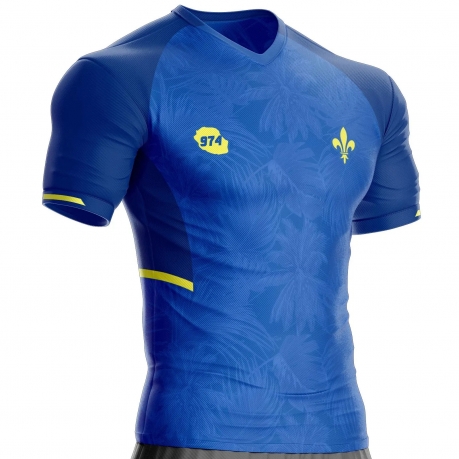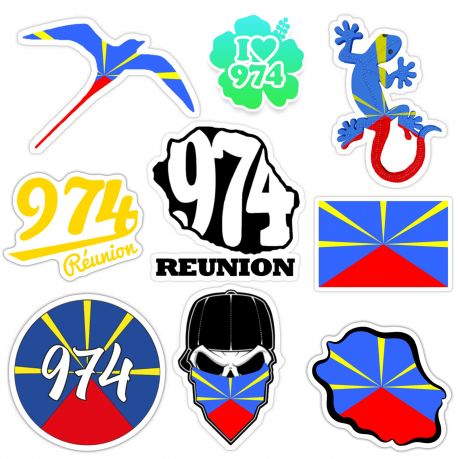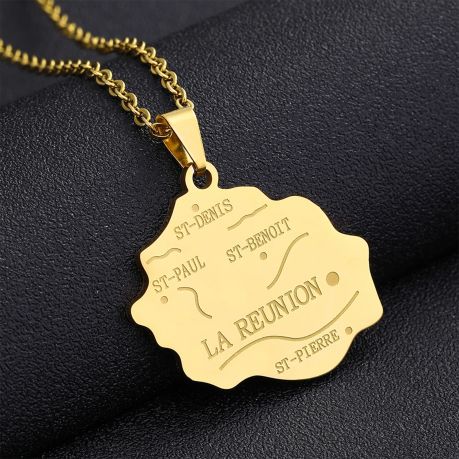The history of football on Reunion Island

The intense island vibrates to the rhythm of football
Imagine a stadium in turmoil, brightly colored fans singing and dancing to the rhythm of the drums, and on the pitch, talented players dribbling with passion. Welcome to Reunion, where football is much more than just a sport, it is a true religion!
With more than 120,000 members, Reunion football occupies a central place in the daily lives of residents. From small villages to large cities, every corner of the island vibrates to the rhythm of local competitions and the exploits of Reunion players.
A French overseas department located in the Indian Ocean, Réunion cultivates a unique passion for football. This fervor translates into an electric atmosphere during matches, boundless enthusiasm for local clubs and immense pride in the Reunion players who play at the highest level.
The history of football in Reunion Island is rich and fascinating, punctuated by strong moments and emblematic figures. Let's discover together the origins of this sport on the island, its evolution over the decades and its ambitions for the future.
The origins of Reunion football (1920-1940)
Football appeared in Reunion in the 1920s, after the First World War. It is said that it was soldiers and sailors returning from the war who introduced football to the island. The sport quickly gained popularity among young Reunion Islanders, attracted by its dynamism and team spirit.
The first clubs
The first Reunion football clubs emerged in the 1920s and 1930s. Often created on the initiative of groups of friends or local associations, these clubs proudly bore the names of their city or region. Among the pioneering clubs, we can cite AS La Tamponnaise, AS Saint-Pierroise, Club Colonial and JS Saint-Pauloise. These clubs, imbued with a certain local patriotism, were a source of pride for their supporters and contributed to the liveliness of villages and neighborhoods.
The practice of football at the time
Imagine wastelands transformed into improvised stadiums, makeshift posts and worn leather balls... It was in these rudimentary conditions that the first Reunion footballers learned to dribble, shoot and score goals. The passion was there, intact and communicative, and the pleasure of playing together far outweighed the lack of means.
Football was a sport accessible to all, a way to let off steam and share a moment of camaraderie. The matches were an opportunity to get together with family and friends, to encourage your favorite team and thrill to the rhythm of the action.
The history of Reunion football does not end there. In the next sections, we will explore the rise of organized football, the emergence of local talent, and the challenges facing the sport today.
The rise of Reunion football (1940-1970)
The structure of football
The 1940s marked a major turning point in the history of Reunion football with the creation of the Réunion Football League in 1946. This institution centralized the organization of competitions and allowed a better structuring of football on the island.
The first championships
The first official championship of Reunion Island was organized in 1947.
The clubs that stood out
Among the clubs which stood out during these first years, we can cite:
La Jeunesse Sportive Saint-Pierroise (JSSP) : the most successful club on the island with 25 Reunion champion titles.
The Club Sportif Saint-Denis (CSSD) : club with 11 Reunion Island championship titles.
AS Excelsior : club with 9 Reunion Island championship titles.
AS Saint-Louisienne : club with 7 Reunion Island championship titles.
The emergence of a Reunion selection
In 1947, the first selection of Reunion Island was created. This selection, made up of the best players on the island, played its first matches against teams from other islands in the Indian Ocean.
The emergence of a Reunionese selection symbolizes the growth of football on the island and the desire of the Reunionese to confront other adversaries and showcase their talent.
Reunion football at a crossroads
The rise of Reunion football in the 1940s and 1950s is an encouraging sign for the future of this sport on the island. However, many challenges remain to be overcome so that Reunion football can continue to develop and reach its full potential.
In the next section, we will explore the challenges facing Reunion football today, as well as its ambitions for the future.
Reunion football facing its challenges (1970-2000)
Geographical distance: an obstacle to development
The geographical distance of Reunion Island constitutes a major challenge for the development of local football. Located more than 10,000 kilometers from the French metropolis, the island is isolated from major training centers and national competitions.
Difficulty reaching high national level
This distance makes access to the high national level difficult for young Reunion footballers. High travel and accommodation costs constitute a significant obstacle for families wishing to send their children to mainland France to continue their education.
Development of sports infrastructures
Despite these challenges, significant efforts have been made to develop sports infrastructure on the island. New stadiums were built and old ones renovated, offering Reunion footballers playing conditions more worthy of the name.
Setting up training structures
The training of young players is also a priority for the development of Reunion football. Training structures have been put in place to supervise young talents and enable them to exploit their full potential.
The future of Reunion football
Reunion football has undergone considerable evolution over the last few decades. Despite the challenges ahead, the future of this sport on the island is promising.
The passion of the Reunion Islanders for football, the development of infrastructure and the establishment of training structures are all assets which will allow Reunionese football to continue to develop and shine beyond the borders of the island.
The new generation of Reunion talents
Talented players like Dimitri Payet, Florent Sinama-Pongolle and Loïc Diony have shown the way forward for young Reunion footballers.
Towards international recognition
The ambition of Reunion football is to be recognized at international level. Participation in the Indian Ocean Island Games and other international competitions is an important step in this quest for recognition.
Reunion football has a bright future ahead of it. With the support of local authorities, clubs and supporters, the island can become a real talent pool and an essential force in football in the Indian Ocean.
Reunion football today (2000-present)
The explosion of passion
Reunion football continues to develop and gain popularity over the years. The enthusiasm for this sport is visible in the stadiums, which are increasingly full during matches, and in the streets, where young Reunion Islanders devote themselves to their passion with fervor.
Reunion players and the metropolis
Many talented players from Reunion have managed to break into mainland France and play in professional clubs. Among the best-known figures, we can cite Dimitri Payet, Florent Sinama-Pongolle, Loïc Diony and Jordan Amavi. These players wore the colors of Reunion high and inspired the new generation of Reunion footballers.
Dimitri Payet, a symbol of success
Dimitri Payet is one of the best-known and most appreciated Reunion players. Trained at AS Saint-Étienne, he played at Olympique de Marseille, West Ham United and Olympique Lyonnais. Today he is an essential player for the France team.
Reunion football and the Indian Ocean
The Reunionese selection regularly participates in the Indian Ocean Islands Games. In 2019, she won the gold medal in the competition.
The ambition for international recognition
Reunion football has the ambition to be recognized at international level. Participation in the Indian Ocean Island Games and other international competitions is an important step in this quest for recognition.
A promising future
Reunion football has a bright future ahead of it. With the support of local authorities, clubs and supporters, the island can become a real talent pool and an essential force in football in the Indian Ocean.
The history of Reunion football is a story of passion, perseverance and ambition. Despite the challenges, the sport has undergone considerable evolution over the past few decades and continues to grow and gain popularity.
The future of Reunion football is promising. The new generation of Reunion talents, inspired by the examples of Dimitri Payet and other players, is ready to write new glorious pages in the history of football on the island.
Assessment of a passion
Reunion football has come a long way since its modest beginnings in the 1920s. From a simple leisure sport played on wasteland, it has become a true passion that punctuates the lives of many Reunion residents.
A sport with unique characteristics
Reunion football is distinguished by its unique characteristics:
Exceptional popular enthusiasm
A deep anchor in local culture
A talented pool of young players
Challenges linked to insularity
An essential element of Reunionese culture
Football is much more than just a sport in Reunion. It is an essential element of local culture, a factor of social cohesion and a source of pride for the people of Reunion.
Towards a bright future
Reunion football has a bright future ahead of it. With the support of local authorities, clubs and supporters, the island can become a real talent pool and an essential force in football in the Indian Ocean.
The hope of shining beyond borders
The new generation of Reunion talents, inspired by the examples of Dimitri Payet and other players, is ready to write new glorious pages in the history of football on the island.
The dream of one day seeing a Reunion Islander lift the World Cup is no longer so distant.








